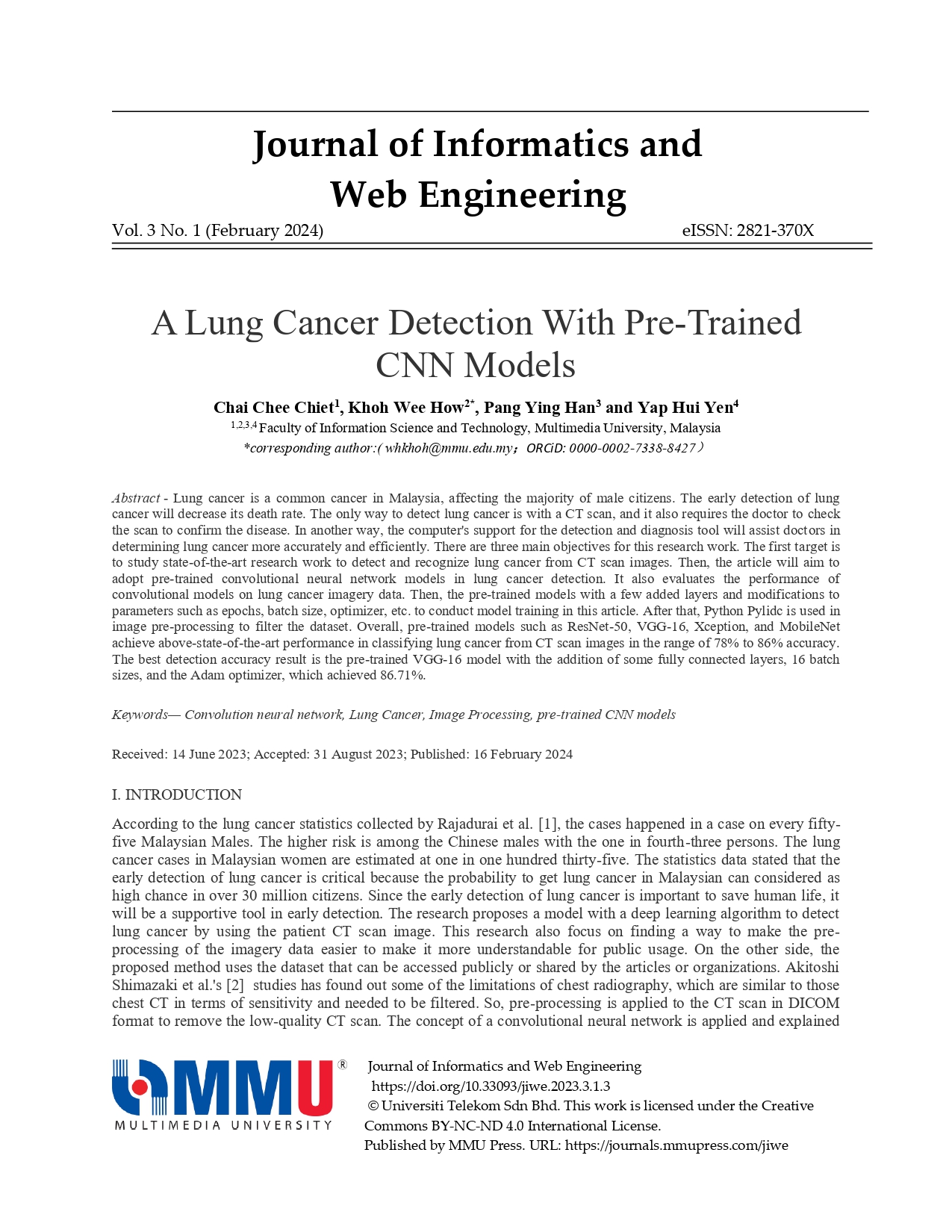A Lung Cancer Detection with Pre-Trained CNN Models
Main Article Content
Abstract
Lung cancer is a common cancer in Malaysia, affecting the majority of male citizens. The early detection of lung cancer will decrease its death rate. The only way to detect lung cancer is with a CT scan, and it also requires the doctor to check the scan to confirm the disease. In another way, the computer's support for the detection and diagnosis tool will assist doctors in determining lung cancer more accurately and efficiently. There are three main objectives for this research work. The first target is to study state-of-the-art research work to detect and recognize lung cancer from CT scan images. Then, the article will aim to adopt pre-trained convolutional neural network models in lung cancer detection. It also evaluates the performance of convolutional models on lung cancer imagery data. Then, the pre-trained models with a few added layers and modifications to parameters such as epochs, batch size, optimizer, etc. to conduct model training in this article. After that, Python Pylidc is used in image pre-processing to filter the dataset. Overall, pre-trained models such as ResNet-50, VGG-16, Xception, and MobileNet achieve above-state-of-the-art performance in classifying lung cancer from CT scan images in the range of 78% to 86% accuracy. The best detection accuracy result is the pre-trained VGG-16 model with the addition of some fully connected layers, 16 batch sizes, and the Adam optimizer, which achieved 86.71%.
Article Details

This work is licensed under a Creative Commons Attribution-NonCommercial-NoDerivatives 4.0 International License.
All articles published in JIWE are licensed under a Creative Commons Attribution-NonCommercial-NoDerivatives 4.0 International (CC BY-NC-ND 4.0) License. Readers are allowed to
- Share — copy and redistribute the material in any medium or format under the following conditions:
- Attribution — You must give appropriate credit, provide a link to the license, and indicate if changes were made. You may do so in any reasonable manner, but not in any way that suggests the licensor endorses you or your use;
- NonCommercial — You may not use the material for commercial purposes;
- NoDerivatives — If you remix, transform, or build upon the material, you may not distribute the modified material.
References
P. Rajadurai, S. Hin How, C. Kim Liam, A. Sachithanandan, S. Yang Soon and L. Mun Tho, "Lung Cancer in Malaysia," Editorial: Lung Cancer Worldwide, vol. 15, pp. 317-323, 2020.
Shimazaki, D. Ueda, A. Choppin, A. Yamamoto, T. Honjo, Y. Shimahara and Y. Miki, "Deep learning-based algorithm for lung cancer detection on chest radiographs using the segmentation method," Scientific Reports, vol. 12, no. 2045-2322, p. 727, 2022.
Mahale, C. Rawool, D. Tolani, D. Bathija and K. Jewani, "). SVM classifier based CAD system for Lung Cancer Detection," ijecs, 2017.
S. Makaju, P. Prasad, A. Alsadoon, A. Singh and A. Elchouemi, "Lung Cancer Detection using CT Scan Images," Procedia Computer Science, vol. 125, no. 1877-0509, pp. 107-114, 2018.
P. Nanglia, S. Kumar, A. N. Mahajan, P. Singh and D. Rathee, "A hybrid algorithm for lung cancer classification using SVM and Neural Networks," ICT Express, vol. 7, no. 2405-9595, pp. 335-341, 2021.
G. Jun Feng, S. QingZeng, L. Z., X. L. and D. XueChen, "Using Deep Learning for Classification of Lung Nodules on Computed Tomography Images," Journal of Healthcare Engineering, p. 7, 2017.
S. Sasikala, M. Bharathi and B. R. Sowmiya, "). Lung Cancer Detection and Classification Using Deep CNN," International Journal of Innovative Technology and Exploring Engineering (IJITEE), vol. 8, no. 2278-3075, 2018.
Y. Li, Y. Tian and B. Ge, "Lung Cancer Classification Using 3D-CNN with a Scheduled Learning Strategy," Advances in Intelligent System, pp. 162-164, 2018.
N. Kalaivani, N. Manimaran, D. Sophia and D. D. D, "Deep Learning Based Lung Cancer Detection and Classification," IOP P Conf. Series: Materials Science and Engineering 994, 2020.
T. Ahmed, S. Mst. Parvin, M. Reduanul Haque and M. Shorif Uddin, "Lung Cancer Detection Using CT Image Based on 3D Convolutional Neural Network," Journal of Computer and Communications, vol. 8, pp. 35-42, 2020.
S. Saha, "A Comprehensive Guide to Convolutional Neural Networks – the ELI5 way. Towards Data Science," 2018.
A. Palma, F. A. Cappabianco, J. S. Ide and P. A. Miranda, "Anisotropic Diffusion Filtering Operation and Limitations - Magnetic Resonance Imaging Evaluation," IFAC Proceedings Volumes, vol. 47, no. 3, pp. 3887-3892, 2014.
F. Chollet, " Xception: Deep learning with depthwise separable convolutions”. IEEE conference on computer vision and pattern recognition, pp 1251–1258, 2017.
J. Brownlee, "A Gentle Introduction to Batch Normalization for Deep Neural Networks," 2019, https://machinelearningmastery.com/batch-normalization-for-training-of-deep-neural-networks/
K. Simonyan and A. Zisserman, "Very Deep Convolutional Networks for Large-Scale Image Recognition," ArXiv. /abs/1409.1556, 2015.
W.C. Feng, "A Basic Introduction to Separable Convolutions," 2018, https://towardsdatascience.com/a-basic-introduction-to-separable-convolutions-b99ec3102728
H. Kaiming, Z. Xiangyu, R. Shaoqing and S. Jian, "Deep Residual Learning for Image Recognition," CoRR, vol. abs/1512.03385, 2015.
G. Howard, Z. Menglong, B. Chen, K. Dmitry, W. Weijun, W. Tobias, A. Marco and A. Hartwig,"MobileNets: Efficient Convolutional Neural Networks for Mobile Vision Applications," CoRR, vol. abs/1704.04861, 2017.

